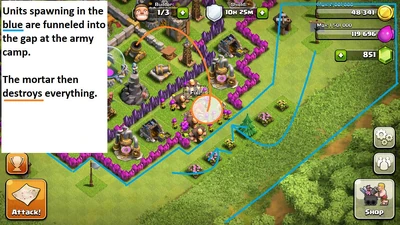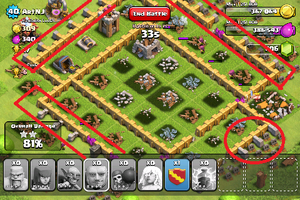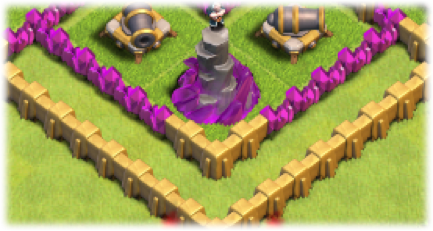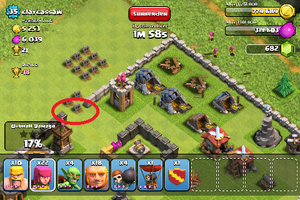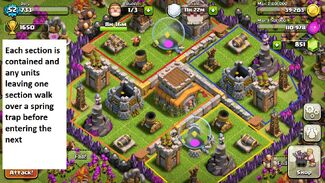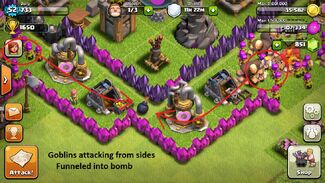Flammy's Strategy Guides: Table of Contents
|
Topic |
Information |
|---|---|
|
A guide for those brand-new to Clash of Clans, focusing on the first three days while under newbie protection. How to start your Clan off on the right foot with optimal efficiency. Frequently Asked Newbie Questions are included along with their answers. | |
|
Basic elements of strategy and good base design. Rules of thumb for designing your first base. | |
|
Chapter 3 Advanced Base Defense |
Advanced base design elements. Common base archetypes. Exploiting pathfinding and AI elements, |
|
Critical before moving onto more advanced attacking is the knowledge of which unit to use, when, and how it will react. This guide covers how to use units most effectively; how they move, and why they act. This chapter goes from the basics to advanced material. | |
|
Understanding the matchmaking system, both how it works and why it matters. Learn its flaws and exploit them. | |
|
Benefits of raiding, ideal raid, limits, restrictions, and details relating to the fine art of stealing resources. Common army compositions and Risk vs Reward. Flammy's version of Farming. |
Welcome
This page is part of Flammy's Strategy Guides. Check it out for links to my other guides as well as notes about editing and reproducing my content. I also produce Clash of Clans videos on YouTube, including a Let's Play (basically a playthrough) starting at Town Hall level 4, so if you're looking for more help and advice, I hope to see you over there.
Are you a tempting target?
The best way to not get attacked is to not make it worth your attacker’s time. There are several things that an attacker will likely attack to get, or not attack due to the presence of.
Large amounts of Loot!
Loot is the #1 reason people will attack at low levels. If you don’t have much to steal, you’re safe! Spend as much as you can on walls prior to starting any upgrade. Spend on removing obstacles when the builder is available. If you don’t have a worker available, start a research project in the Laboratory (elixir ) or buy decorations (gold and elixir). Note that gold not collected (in Gold Mine or Elixir Collector ) can be stolen. Other ways to spend resources - Queuing units (even when your army camps are full), building spells, starting the research, buying defenses (Bombs/Spring Traps ), buying decorations (flowers and flags).
Having easily accessible loot
Accessible loot comes in two types - accessible mines/collectors and accessible storage. Both are bad. Make sure your storage is either empty or in the middle of your base. Make sure your mines/collectors are next to your walls (and therefore next to your defenses). Uncollected resources are easier to steal than collected ones - the buildings are more spread out and the buildings have lower HP.
You should also intermix your elixir collections and mines as well as your elixir storage and gold storage. If an opponent really wants your gold, and all of your mines are together in a nice line, it is much more tempting of a target as not as much needs to be invested to steal the single resource they are seeking. Similarly, make sure your two gold storage are not next to one another.
Looking like your base is difficult
Upgrade your walls as a high level as you can, the higher the level the more difficult it looks for players at your trophy level. Do not upgrade willy-nilly, upgrade each one, one-by-one, even though it's a pain.
Having a Good Base
See Flammy's Base Defense Basics for details (Common issues: not protecting your defenses, mortar and air defense placement, everything-inside-walls issue, spread out defenses). Also having defenses that are significantly below the ‘normal’ upgraded amount for your trophy count/level. Here are a few more common bases and what I think of each.
The Standard Base
The standard base follows all of the rules laid out in Flammy's Base Defense Basics - Defenses and storage inside of the walls; army camps, barracks, mines, extractors, etc. outside of the walls. There is a single wall dividing your precious base from the hordes of horrors outside. Now What? How can you improve your base? Well, this standard base is weak to giants as once they breach your wall, they can attack all of your defenses without delay. It is also weak to mass goblin attacks for the same reason - Once inside they can often outrun splash damage and steal all of your goodies, possibly leaving you with a victory, but with much fewer resources to spend.
The Pocketed Base
This base has the town hall in the center, and every defense around it is surrounded by its own 4x4 wall. They are good against giants as the walls slow them down, whilst keeping the defenses close together. They are best attacked with giants and archer support.
The Large Pocketed Base
This base is a variant on the pocketed base, where each pocket has 2-3 structures in each pocket. It is more efficient in terms of wall usage than the pocketed base, allowing for more buildings to be placed within the walls. People who love symmetry in their bases will like the 3 pocket base, as it creates a nice spiral with no wasted space or walls. The differences between this and the Pocketed Base are minimal. This base type is more common than the Pocketed Base at lower levels due to lack of walls.
The Bulkhead Base
A Bulkhead Base follows the rules laid down in Flammy's Base Defense Basics about kicking un-needed buildings outside of the walls, then uses extra walls to segment defenses into different sections allowing for greater protection in case one section is breached (especially by giants). Bulkheads are used in large boats to prevent the entire boat from sinking in case of a leak below the waterline - The flooded sections are closed off via built-in bulkheads, containing the flooding to only the affected sections. In the same way, bases use this strategy to contain (or slow) the flood of enemy troops to the breached bulkhead - While with a single wall layer a breach would mean your village is headed to destruction.
The Split Base
A common (but poor) base defense strategy is grouping your defenses into two groups, with critical non-defensive buildings between them (Town Hall, Resource Storage). This defensive strategy seems to not violate the rules I’ve put in Flammy's Base Defense Basics, but it actually violates the rule of not keeping your defenses too spread out. Your defenses should be able to cover each other, ideally as much as possible - keeping them in two groups should be avoided. Split base defense is very vulnerable to giant attacks as they can clean up half of the defenses without taking fire from the other half. Split bases also mean that if either side is wiped out, your critical buildings in the center are very vulnerable to a few archers attacking from that side, effectively meaning your base is half as weak as otherwise.
Funneling for Victory
Funneling is critical to getting the best results out of your splash damage dealing turrets. It basically means using buildings (mostly walls) to make your enemy go where you want it to go, and then die as you want it to die.
The image to the right shows how my current base funnels enemies.
Do I need to say more? Funneling is also critical to proper trap usage. See Placing Traps, below.
Upgrading multiple defenses at the same time
Your defenses don’t attack if they’re in the middle of being upgraded when you’re attacked! Try not to be upgrading 40% of your defenses at the same time. This is doubly true for splash damage buildings (mortar, wizard tower) and air defense.
Having a glaring flaw in your base
Such as a spawn point where you moved a turret out of but didn’t put anything back. Or not having an air defense turret. Or putting your Air Defense outside of your walls.
Buildings outside walls are too spread out
At higher levels, more players start caring about trophies. If an attacker sees your base is easy to 1-star (kill 50% of the buildings) without having to place too many troops they will see you as a good target. Keep your buildings close to your walls (and defenses) to prevent this, if you care about maintaining your trophy count.
Turret Range Considerations
What can your towers defend? One of the goals of placing less valuable buildings outside of your walls is to slow down your attackers once they are within range of your defenses. NOT to make them spawn farther back - This is of secondary priority. This section covers what that range actually means. Range in this game is also sorta screwed up - Sometimes a turret will decide it can attack a unit standing in a given square, but on another base (with the identical unit and turret placement) it won’t attack. This ambiguity is why it has taken me about 2 weeks longer to post Chapter 2 than I was hoping. I still haven’t figured out why it does this.
What can and can’t be attacked without taking return fire is summarized in these pics.
Cannon- Range 9;
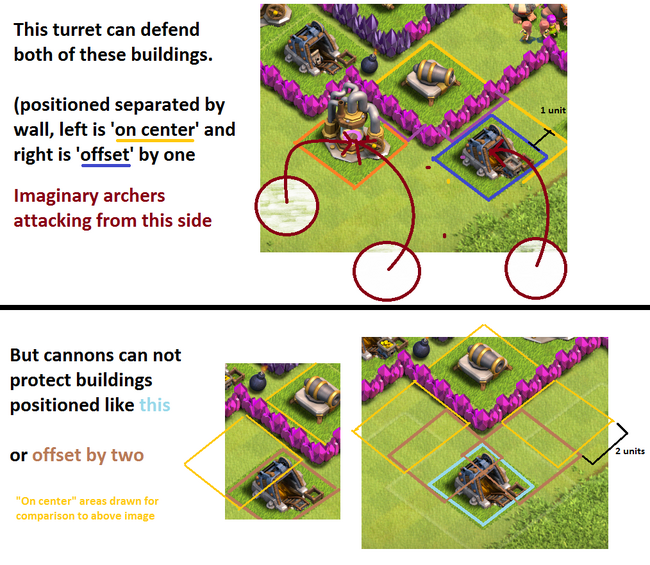
Archer Tower- Range 10;
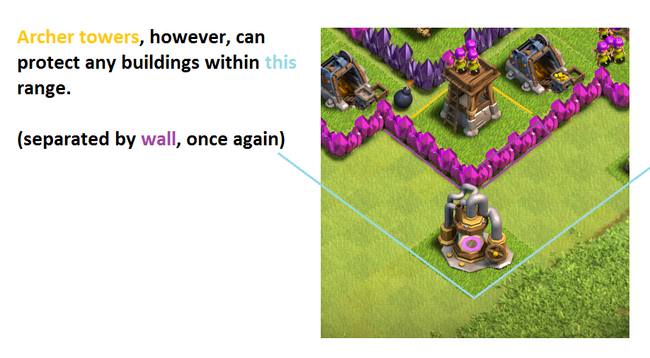
Archer - Range 3.5.
Spawn Forcing
Spawn forcing refers to forcing your opponent to spawn further away from your important buildings, or your base in general. The objective is to attempt to persuade your opponent to attack from a different side of your base and to delay their reaction time (placing reinforcements). You can create this gap outside of your base by arranging your exterior buildings, placing extra walls, placing decorations and utilizing natural decorations. Note: This no longer works, as of the March 12, 2013 update which allows players to spawn directly on top of obstacles and decorations. It is not recommended to use buildings to force your opponent to spawn further away, as buildings are more useful to delay your opponent once they are in the range of your turrets. However, if you spread out your walls in singles (optimal distribution to create a large no-spawn-zone) wall breakers will never attack them. Spawn forcing allows your defenses to kill many wall breakers before they get to your walls if they are unsupported. For other wall breaker defense tips, see decoy walls below. If allowed to spawn directly next to your wall, wall breakers are able to detonate before turrets can strike, even if the wall breaker would normally be one hit by the turret.
Trick Spawns
Trick spawns are ‘mistakes’ in a spawn forcing situation. Usually a single hole, they are closer to the center of your base than the rest of the spawn force allows. However, they are intentional and you should make sure you have turrets (especially mortars ) barely within range of the spawn square in question.
Why use trick spawns?
Spawn tricks are fun (I’ve had an opponent put down 31 archers in a trick spawn just to have them all die to a single mortar hit - they didn’t opt to continue attacking). Normally they don’t matter but occasionally they help. If created without care, they can allow your opponent an advantage (such as if they can deploy wall breakers). It is inadvisable to rely on traps to defend a trick spawn - if you get attacked twice in a row they won’t be there the second time, plus a smart attacker will place a single unit in the square in question to test for traps.
Messing with Wall Breakers
Wall breakers are often used in conjunction with giants to get them through the outer walls faster. Here are a few tips to mess with the Wall Breaker AI.
| Forthcoming Update! Improved Wall Breaker training techniques have revolutionized the cunning of these fearless demolitionists. Wall Breakers now maximize the potential of each and every bomb, avoiding decoys and distractions. |
Decoy Walls
Decoy walls are segments of walls of at least 8 that wall breakers will target if they are closer than your real walls. Wall Breakers now target based on compartments. They can also be used to funnel archers and barbarians into taking lots of splash damage from mortars and wizard towers. Segments of 7 or less don’t seem to work most of the time (seems to be partially based on spawn proximity). If you do further testing and discover any additional details, please report back (for science).
Outer walls with Buttresses
PLEASE NOTE: As of the March 12th, 2013 update, the Wallbreaker's AI now targets the nearest compartment NOT wall. This makes this technique obsolete.
When used in-game they look like this. The wall breaker will attack the buttress rather than the walls. Giants will ignore them and proceed straight to the inner walls. Only once the nearby buttress is destroyed will the Wall Breaker target the main wall. This works especially well with spawn forcing, as the farther away the wall breakers spawn the more likely they will target several buttresses, rather than several targeting one buttress and then the surviving ones re-targeting onto the main wall. They can also be combined with Decoy Walls - See pictures of my base in the funneling section for how I use them in such a situation.
If you're curious about the name, see here.
Using extra walls for Buffering
Visual of buffering If you have extra walls, you can also use them to protect your defenses from archers by extending the distance between your turret and the offensive units. They simply prevent archers from getting close enough to fire, however, they do cut down on the number of buildings outside the wall your turret can protect so I generally only recommend this for situations where you: 1) DON'T want archers attacking from, 2) have walls to spare, and 3) don't have buildings which can defend your turret instead. This situation can be considered the advanced method of 'Defending your Defenses' (from Flammy's Base Defense Basics) but is generally not viable to lower level players due to the number of walls necessary.
Upgrading walls
Walls should be upgraded in the order that they get attacked, generally outside towards inside. I generally discourage placing walls right around your Town Hall in the center of your base - If the enemy gets that far you are dead anyway. This also explains why your best walls shouldn’t be in the center of your base. Rather, upgrade your critical junction walls first - walls that are shared between more than two pockets. (Read The Pocketed Base; if you don’t get what I mean by pockets) as well as exterior corners (due to wall breakers). Lastly, upgrade walls that are likely to be attacked by giants going after your defenses - namely the walls just outside of the defenses themselves. I am not saying you shouldn’t upgrade all of your walls, just that you should focus on them in this order.
Oh, and DO NOT upgrade your walls in a polka dot manner.
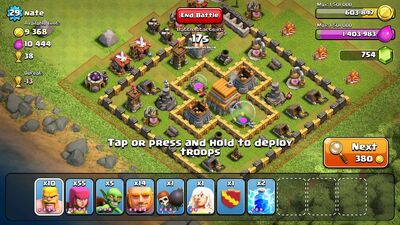
Polka dot upgrade style. BAD.
See the image on right.
There is no point. Wall breakers will damage three or so walls at a time, so the ‘weak’ wall will be hit just like the strong one.
Placing Traps
Place traps where enemies will be funneled into them. Don’t spread them out randomly, that just wastes money. Don’t place them in a predictable pattern - If I am attacking a base and hit two traps close to one another, I will deploy a few singleton troops where I would expect further traps to be just to clear them out. Do you really want to waste 4 bombs in a row on one barbarian? Or a spring trap on a single archer because you placed them evenly on one side of your base?
Don’t place your traps in an ‘entrance’ gap in your walls like the image to the right. Even worse is an entrance hall - It is a blindly obvious thing to do and a single goblin running down your entrance hall will trigger every bomb and spring trap and escape unharmed. Then you've just spent several thousand gold for no real reward. You no longer have to rearm traps.
Here is how I use traps in my base.
Clan Castle Placement
Clan Castle reinforcement troops will be deployed once the enemy enters the Clan Castle’s range. The troops will then jump and fly out over the walls to attack the enemy. The Clan Castle troops will target whoever activated them first, even if other units are closed on their way after their target. This section is rather long as many people don't use the Clan Castle properly. The Clan Castle can be most effectively used with a Standard Base or a Bulkhead Base using the following method:
The best use of your reinforcements is to delay your enemy while your defensive structures attack them. Because both the reinforcements and the attacking troops will only target one unit (50 enemy archers will all target the first reinforcement archer, all fire on her, leaving the other 9 units unhurt). This means your 10 (or more!) reinforcements can delay enemies for a very long time while they are slowly targeted down one by one. When used in this manner the level of the troops doesn’t matter, as once they are targeted they are usually hit by 50 arrows which are enough to kill both a level 1 archer and a level 5 archer. When used this way, this also means having 5 archers or 5 barbarians is much better than having 1 giant. While the giant has more health, it takes fewer volleys to kill than 5 individual archers, effectively delaying the enemy for less time despite its higher health. This makes the positioning of your clan castle especially important. Note bulkhead bases may want to leave a hole (http://i.imgur.com/AiCcC.png) for the reinforcements to move though, depending on the design. If you leave a hole like this, try to also leave a spring trap in it! The only thing you shouldn’t do for sure places your clan castle in a partition by itself.
Finally, you should be aware that reinforcement troops can be killed by your own spring traps if the enemy triggers them while the reinforcements are standing on them. So don’t place spring traps around your Clan Castle, especially if it is outside of the walls. The same is NOT true for bombs and giant bombs.
Tips and Tricks for Base Defense
- Place turrets under construction in places that Giants might notice them and get distracted attacking (Like just outside your walls in range of your active defenses ).
- Enemies can spawn on Decorations or on top of hidden tesla coils, and natural elements (trees, bushes, rocks), With the March 12th, 2013 update enemies can spawn freely on Hidden Teslas and Decorations.
- Hide a building in the corner of the map to possibly save yourself from getting 3 starred if the attacker is running out of time. Placing more than 2 is probably overkill, but you could place one in each corner if you really really care about it.
- Enemies can walk across decorations and natural elements - Don’t use them as part of your wall!
- Be sure to request troops and keep your clan castle full, the troops will be deployed in case of an attack.
- Review bases for others around your level by “visiting” them - If you like a design, steal it! Viewing allies in your clan will show you their trap locations as well.
- Reinforcements from the Clan Castle can die from allied spring traps if they are in the wrong place when the trap happens to be triggered. :(
Conclusion
Getting a great defense working is enjoyable as you can watch people repeatedly smash themselves against it and lose :)
Thanks for reading Advanced Base Defense. Hope you enjoyed it. Feel free to provide feedback, questions, and comments in the comments section.
You can find more of my guides at Flammy's Strategy Guides. Check it out for links to my other guides as well as notes about editing and reproducing my content. I also produce Clash of Clans videos on YouTube, including a Let's Play (basically a playthrough) starting at Town Hall level 4. Thanks again for reading, and hope to see you on my YouTube Channel.
Feedback
If this Strategy Guide contains any inappropriate content, please report it here: Clash of Clans Wiki:Report


